Paris was, in essence, created by the Seine. Once upon a time, a string of islands stretched along the river.
Today, there are only two — the Île de la Cité and the Île Saint-Louis. You should definitely take time to see them both! I always take a stroll there on every visit to Paris.
The Île de la Cité is the historic heart and geographical center of Paris, a place that Victor Hugo called the “very marrow of Paris.”
The island was the birthplace of the French capital. Its strategic position on the Seine made it a major Bronze Age settlement.
Since then, the Île de la Cité has been an important administrative and religious center. It’s Paris’ medieval heart and is home to some truly amazing architectural gems.
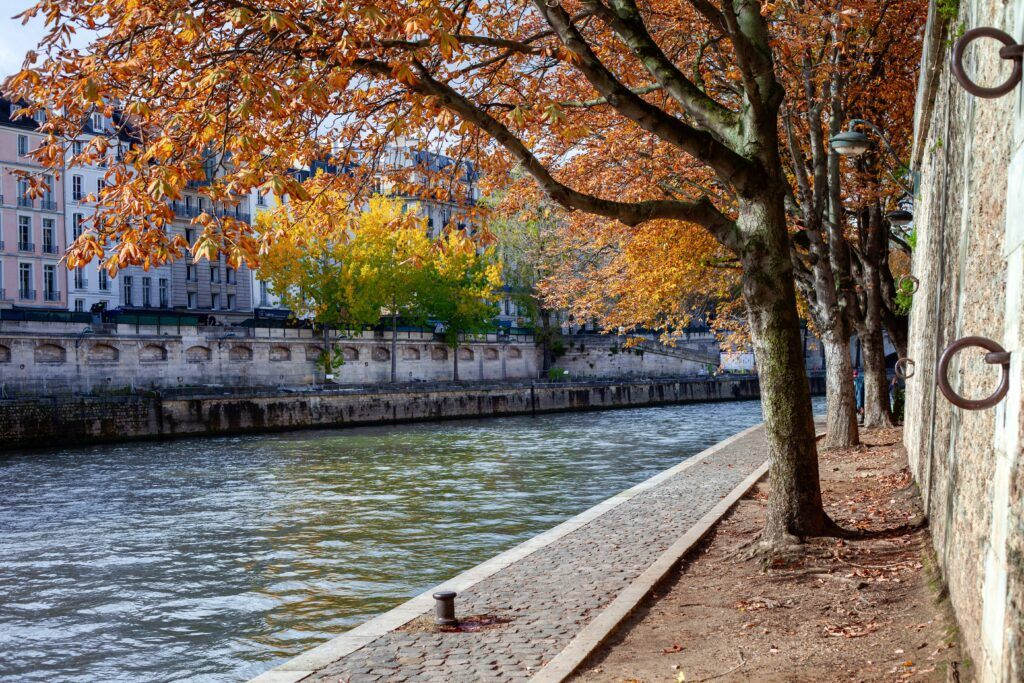
Despite the hoards of tourists and buses parked on the square in front of Notre Dame, there are still some secluded spots on the island.
The Île Saint-Louis is much more quiet and secluded. It’s known for its cobbled streets and riverside views.
On a leisurely stroll, you can admire the elegant 17th century architecture, private mansions, and test out the ice cream at Berthillon.
In this guide, I’ll cover all the top attractions on the islands of Paris. Here’s a quick snapshot of what you can see:
- Notre-Dame Cathedral
- Parvis Notre-Dame
- Deportation Memorial
- Marche Aux Fleures
- Sainte-Chapelle
- Conciergerie
- Place Duaphin
- Square du Vert Galant
- Pont Neuf
- Île Saint-Louis
You may want to book a walking tour of the islands.
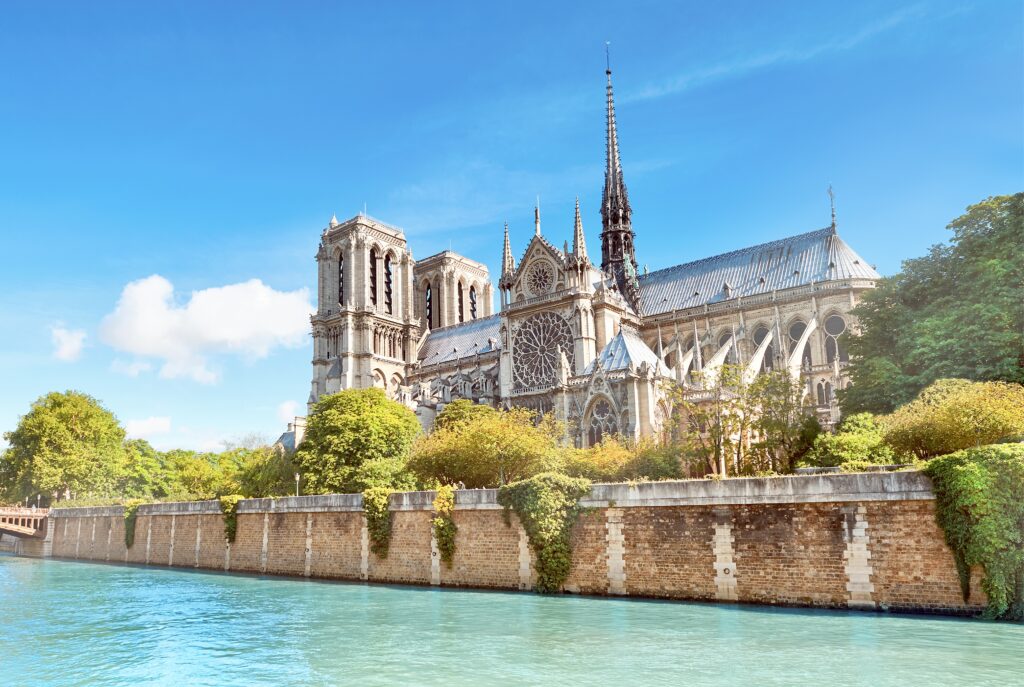
What To Do On Paris’ Islands
Notre-Dame Cathedral
The #1 attraction on the islands, of course, is the world famous Notre-Dame Cathedral. The vast “symphony in stone” is the very symbol of the city.
The cathedral is rich in history. It stands over the ruins of a Roman temple to Jupiter, a 4th century church, and a 6th century basilica.
By the 12th century, the basilica was in ruins. The bishop of Paris decided to replace it with a grand cathedral designed to rival the Cathedral-Basilica of Saint Denis.
Pope Alexander III laid the first stone in 1163, beginning what would become a masterpiece of French Gothic design. The cathedral was completed in 1345.
During the 17th and 18th centuries, with the Gothic style out of vogue, the cathedral was neglected. The beautiful rood screen was removed, though a fragment can be seen in the Louvre.
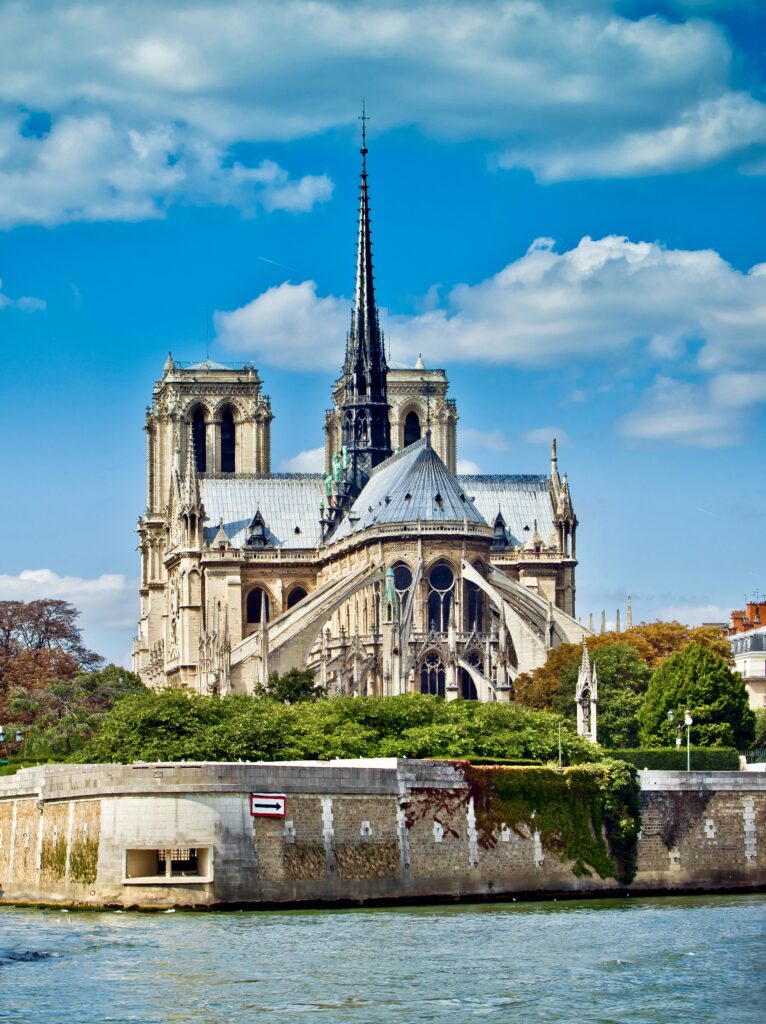
During the Revolutionary War period, Notre-Dame was pillaged. Revolutionaries burned down the treasury and smashed 28 statues of the kings of Judea, mistakenly thought to be the French kings. Somehow, 21 heads survived are one of the highlights of a visit to the Cluny Museum.
In 1831, Victor Hugo published his novel The Hunchback of Notre-Dame. That sparked rallies and efforts to save the cathedral. A huge restoration began.
The renowned 19th century architect toiled away for 20 years. He added the 300 foot steeple embroidered with floral motifs.
In 2019, flames broke out inside the cathedral. The fire destroyed much of the wooden roof and spire and weakened the structure of the building. But firefighters and others rescued many of the relics, including the Crown of Thorns. They were placed in the Louvre.
After the fire, hundreds of millions of dollars in donations were collected for reconstruction. The cathedral is slated to reopen in December 2024. I know I can’t wait to return!
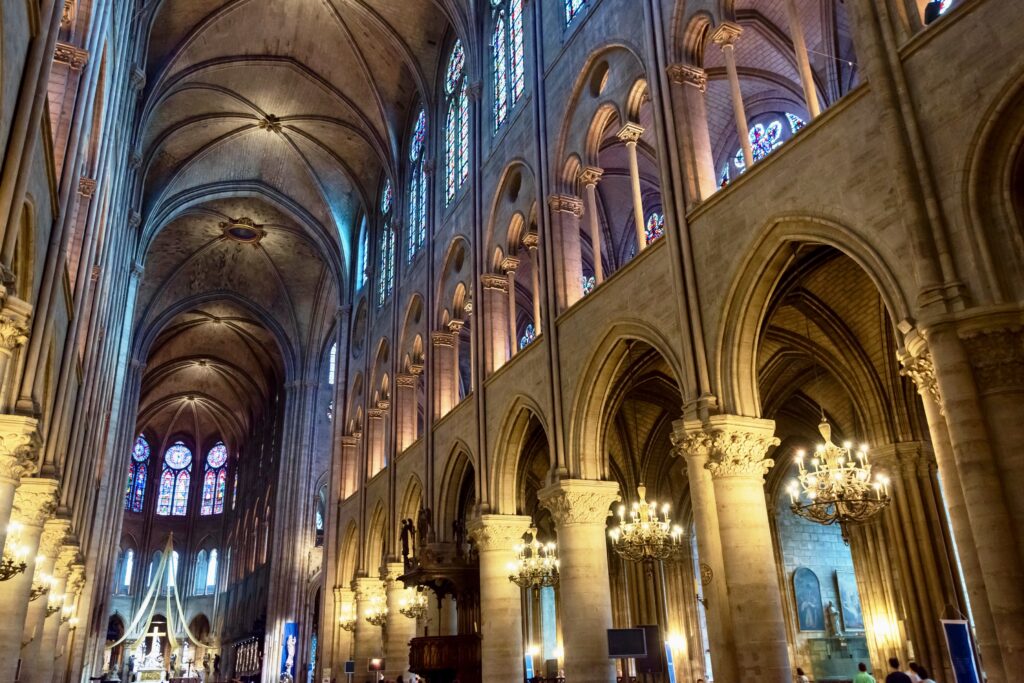
What makes Notre-Dame so special?
The facade is extraordinarily beautiful. Three portals grace the western facade. They’re decorated with carvings and figures of kings from the Old Testament.
Two elegant twin towers frame the portals, which are topped with tall lancet windows and gargoyles.
In the center is a glorious rose window, 69 feet in diameter. It has nearly intact 13th century glass.
To the west at the back of there cathedral, you can see the flying buttresses, the archetype of Gothic architecture.
The gargoyles, which you can see up close on a climb, are actually from the 19th century. They were added by Viollet-le-Duc.
Some gargoyles serve as water spouts. Others are purely decorative and were meant to ward off evil spirits. Over the years, some of the gargoyles acquired names like “the Vampire” and “the Devourer.”
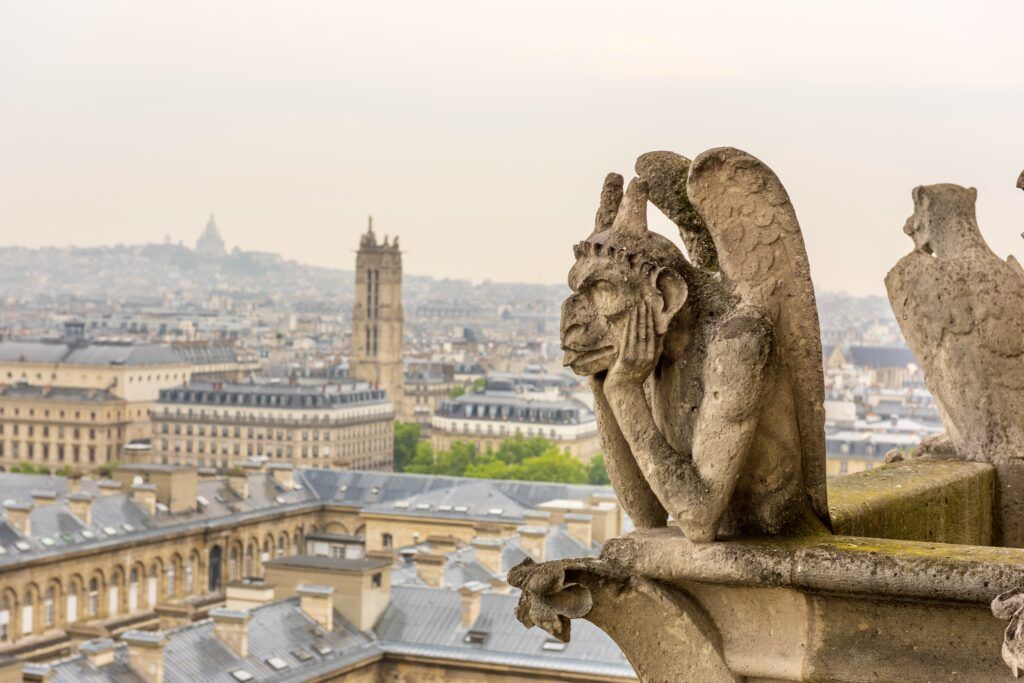
The cathedral’s interior features a three level elevation, consisting of large arcades on the ground level, a triforium (a shallow gallery of arches) above, and a clerestory (the upper level of windows) at the top.
Treasures include Jean Ravey’s ancient choir screen carvings, Nicolas Cousou’s Descente de Croix sculpture, and Antoine Coysevox’s state of Louis XIV.
There are religious paintings by Charles le Brun in the side chapels. Treasures include the Crown of Thorns, the Holy Nail, and a fragment of the True Cross. They are only on display once a year.
Though still closed, you can opt to travel back in time and see the cathedral on a virtual reality tour.
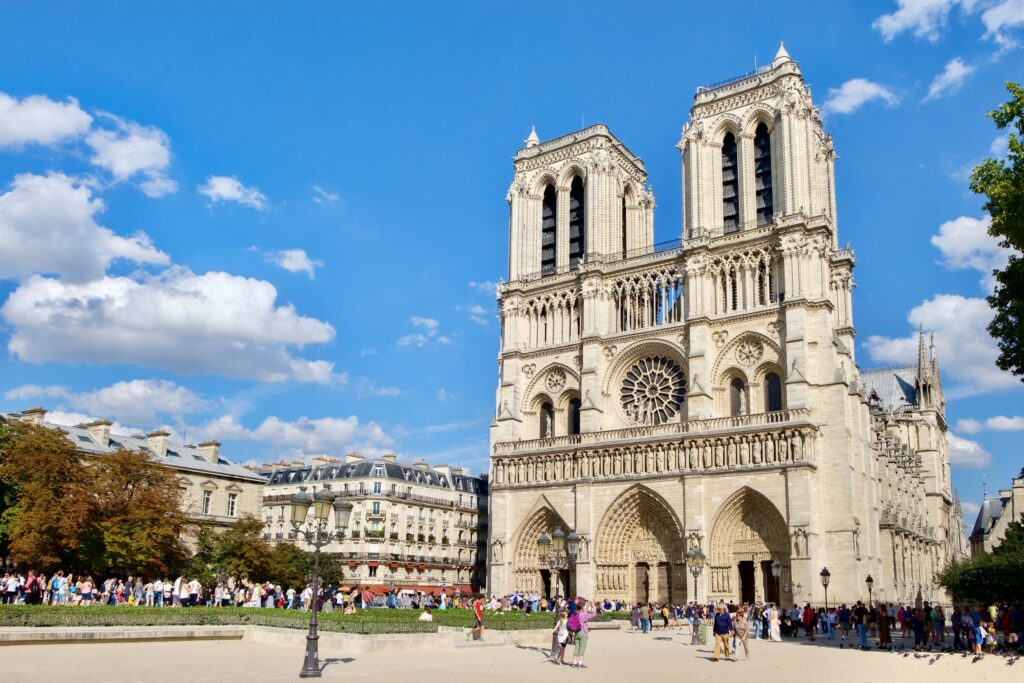
Parvis of Notre-Dame
The parvis is the square in front of the cathedral. It’s presently six times larger than it was in the Middle Ages.
Places on the ground indicate the old layout of the streets and city landmarks. You’ll find a statue of Charlemagne.
Beneath the parvis is an archaecological crypt with the ruins of Gallo-Roman fortifications. They were discovered in 1965 and reopened to the public in 2022.
>>> Click here to book a ticket to the crypt
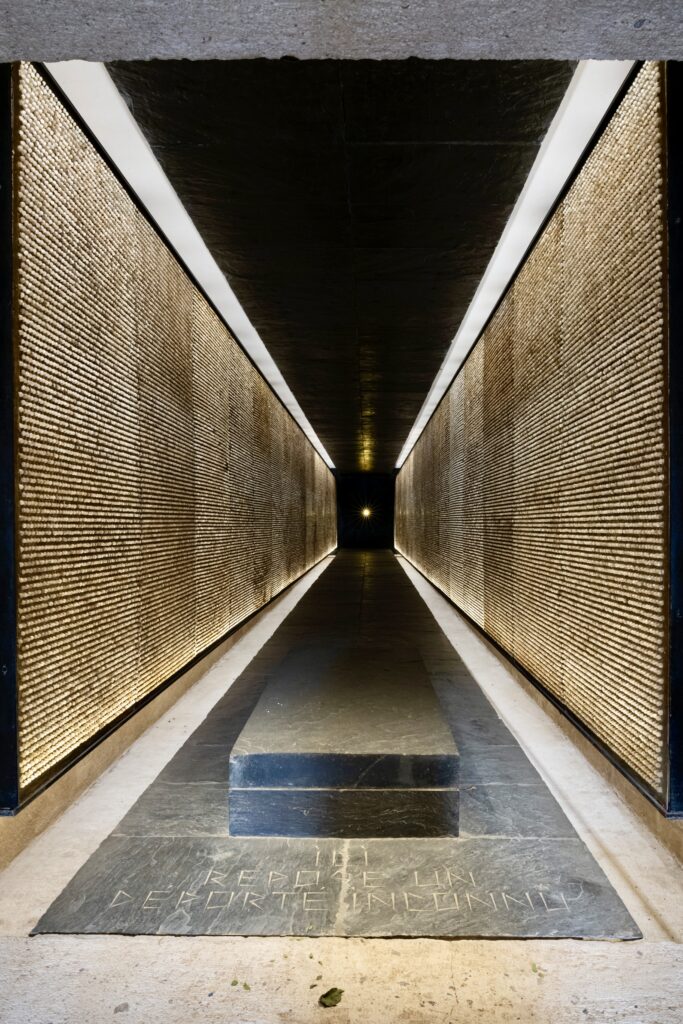
Memorial de la Deportation
Behind the cathedral is the subterranean Deportation Memorial.
It’s a stark edifice commemorating the Jewish people who were deported to concentration camps during WWII. It’s faced with stone quarried from all the mountain ranges in France.
Narrow staircases lead down to a high walled platform, where grates and iron bars evoke a sense of the loss of freedom.
Inside the crypt are two side galleries. There is a small series of niches with the names of concentration camps.
A long, dark gallery with glass chips symbolizes the deportees. it holds the remains of an unknown deportee.
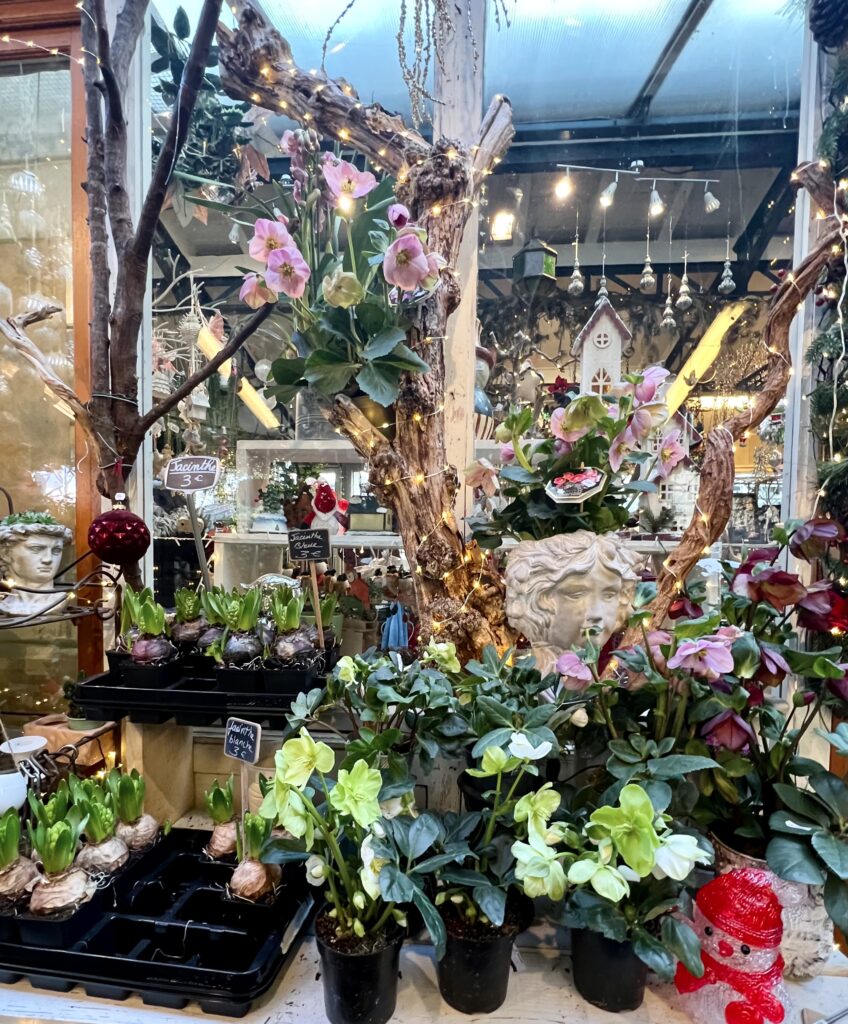
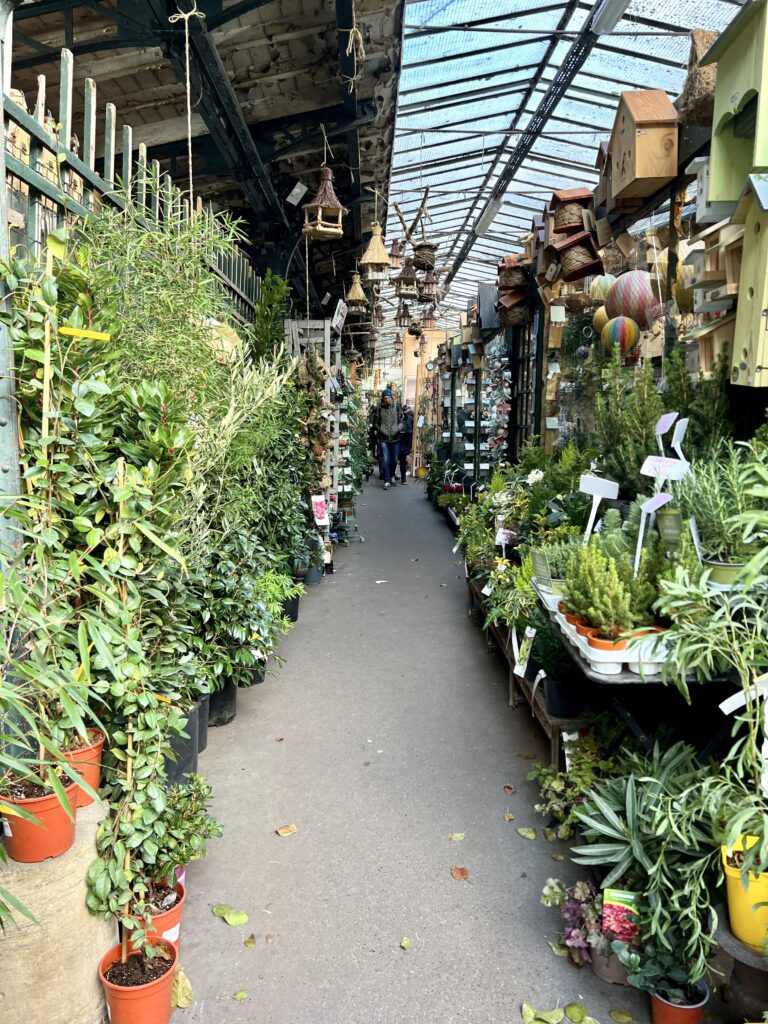
Marches Aux Fleurs
In Place Louis Lepine, you will find the islands’ lovely Flower Market.
The market operates every day of the week, offering a vibrant and colorful selection of flowers, plants, shrubs, and garden accessories.
Visitors can find everything from seasonal blooms to exotic plants and even young trees. You’ll find all manner of flowers — camellias, orchids, jasmine and bamboo.
On Sundays, the market transforms into a bird market, the Marche aux Oiseaux. Vendors sell birds, cages, fish, and other small pets and accessories.
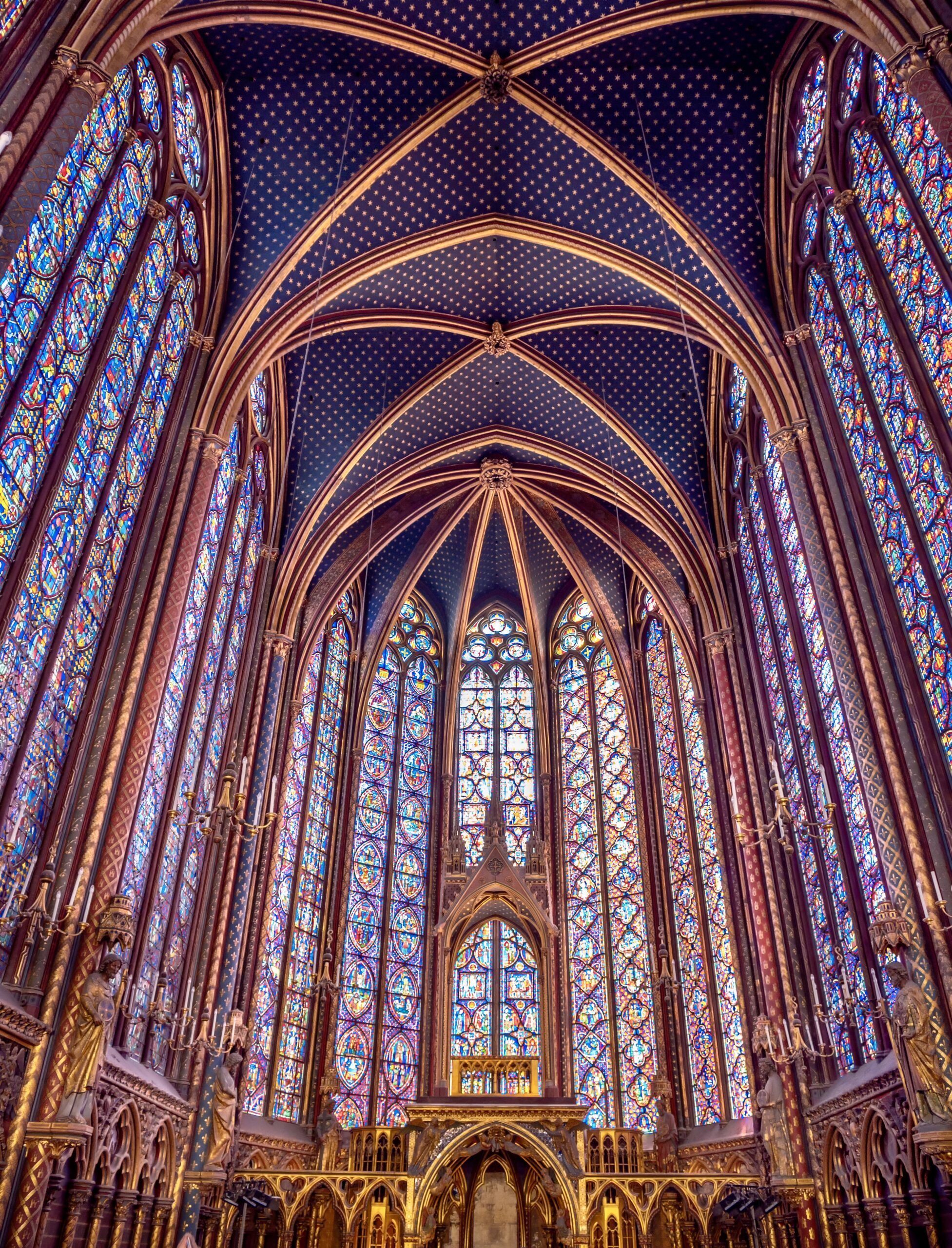
Sainte-Chapelle
Sainte-Chapelle is am absolute must visit attraction on Paris’ islands. It’s a glorious example of high Gothic style and universally recognized as a masterpiece of architecture and stained glass. There’s simply nothing like it!
Louis IX had the chapel built in a speedy 6 years from 1242 to 1248. It was essentially intended as an enormous reliquary to house the Crown of Thorns. (later moved to the cathedral).
Louis was crowned when he was only 12. He purchased the crown from the Emperor of Constantinople. It was a potent symbol of his claim to the throne.
The spectacular chapel is is divided into two sanctuaries: a lower chapel (for palace staff) and an upper chapel (for the royal family and dignitaries).
The lower chapel is dark and richly decorated in vibrant blue and red colors. It’s dedicated to the Virgin Mary.
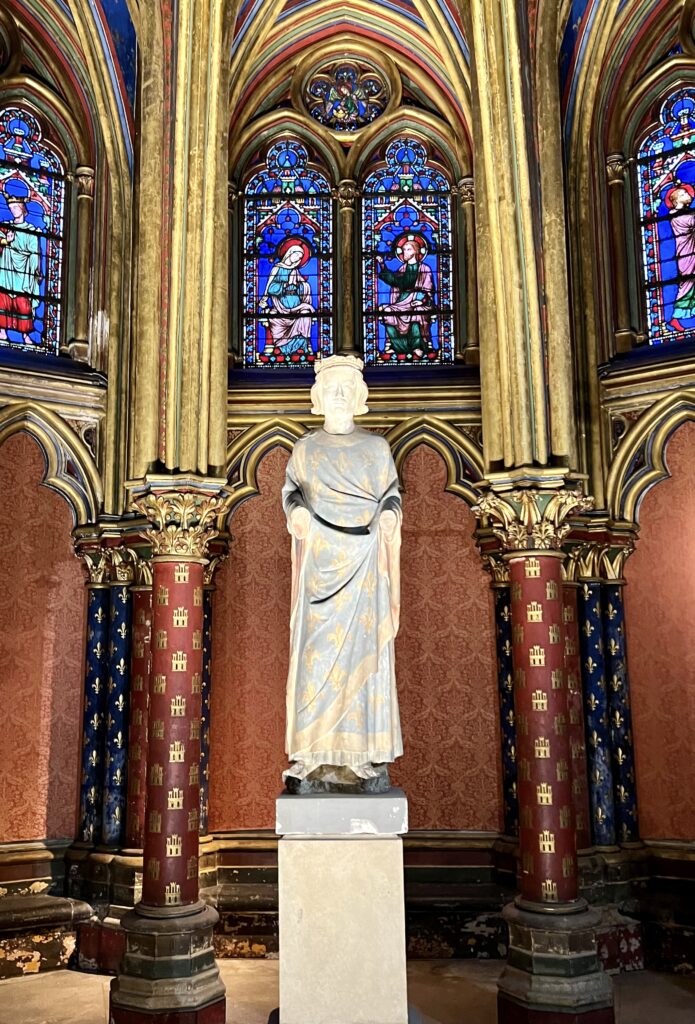
The slim pillars boast a design of fleur de lis set against a vibrant blue backdrop, while the more robust columns are adorned with gold fortresses on a scarlet field. The tops of these columns are embellished with golden acanthus leaves, adding a touch of elegance.
This colorful ornamentation was introduced in the 19th century, during a period of revival aimed at restoring the cathedral’s medieval aesthetics.
This endeavor enlisted the expertise of France’s most esteemed architects and craftsmen, striving to bring the historical decorations back to life.
The upper chapel is simply breathtaking. The wall are a mosaic of colored light that streams through 50 foot high windows. The colors are intense blue, red, purple, green, and yellow.
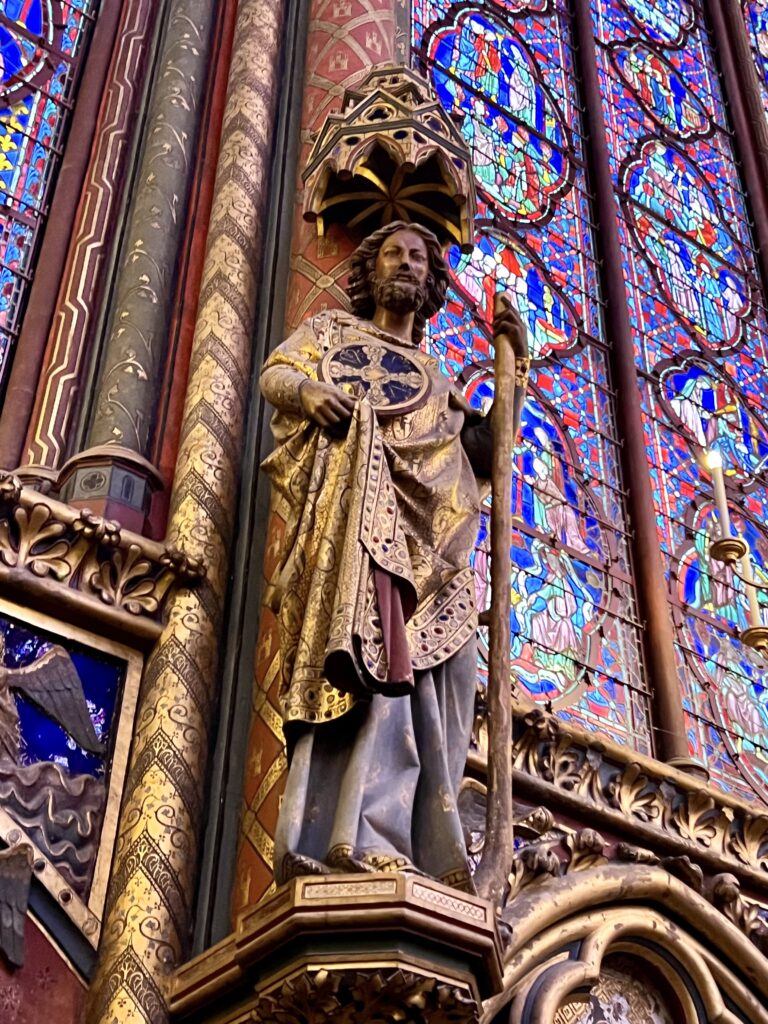
There are over 1,100 scenes, mostly from the Old Testament. 2/3 of them date from the 13th century.
Tips: To see this effect in its full glory, it’s best to visit on a bright and sunny day and bring some small binoculars. You can also download the “Sainte-Chapelle Windows” app on your mobile device. It allows you to closely examine each stained glass panel and discover its meaning.
The rose window dates from 1485 and represents the apocalypse. There are also sculptures of apostles, placed on the structural pillars of the chapel.
To avoid long lines, I highly recommend pre-booking a skip the line ticket on Tiqets. The chapel is so lovely, you may even want to book a guided tour.
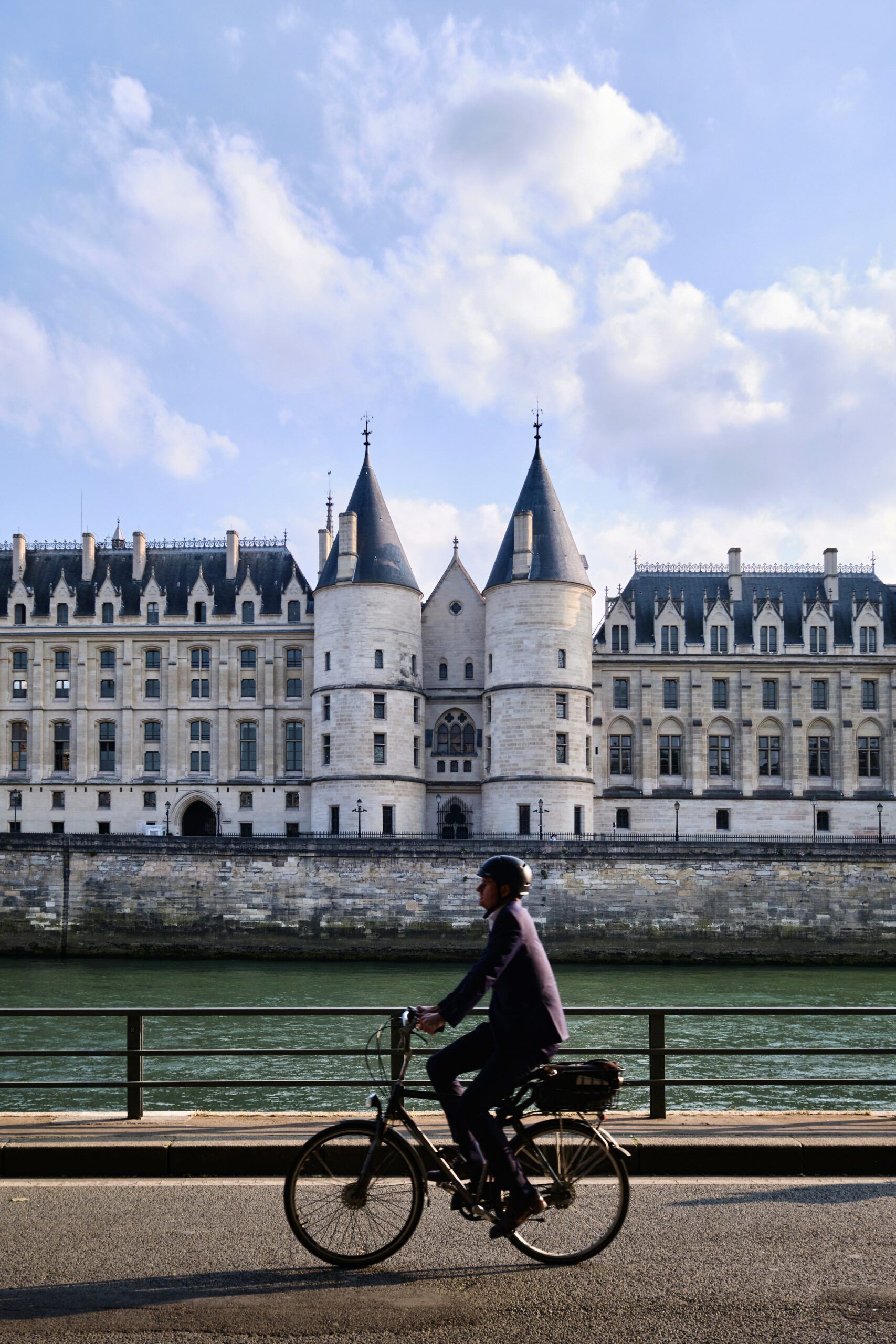
Conciergerie
The Conciergerie is another top attraction on the islands of Paris.
It was part of the royal palace from the 10th century to 1378. When Charles V moved the royal residence, he appointed a concierge, or keeper, and the complex became a prison.
You enter via the impressive Salle des Gens d’Armes, a UNSCO-listed example of secular medieval architecture.
The hall served as the refectory, or dining room, for the palace staff. There are four massive fireplaces.
During the Revolution, the Conciergerie became the “antechamber of the guillotine,” the last stop before prisoners were marched to the guillotine at the Place de la Concorde and executed.
You can walk upstairs to see reconstructed cells of wealthy prisoners, including a reconstruction of Marie Antoinette’s cell. (The poor slept on straw.)
>>> Click here to pre-book a ticket
Place Dauphine
The serene Place Dauphine is one of Paris’ most beautiful squares. It’s one of the few areas of the islands to escape Haussmann’s dramatic redevelopment scheme in the 19th century.
Completed in 1616, the square was named after the Dauphin of France (the future Louis XIII). It’s a triangular square hidden behind the Palais de Justice and accessible via the Pont Neuf.
Its entrance is marked by a narrow point that opens up into a quiet, tree-lined space. It’s flanked by elegant, symmetrical buildings of classic French architecture.
Once a commercial hub, it’s now a peaceful area with a few select cafes and bistros, offering a glimpse of Parisian life away from the typical tourist paths.
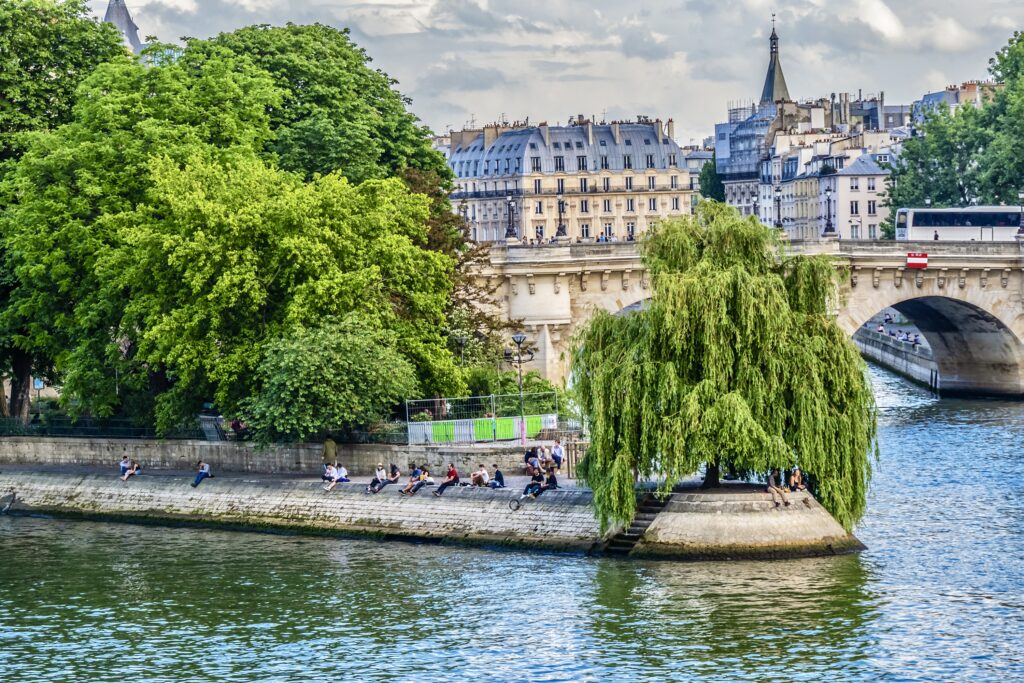
Square du Vert Galant
Square du Vert-Galant is a small park located at the western tip of the Île de la Cité past Place Dauphine. It’s right at the point where the island splits the Seine River into two branches.
Named after Henri IV, the park is known as the “Vert-Galant” for his many romances. It offers panoramic views of the Seine and is a popular spot for picnics and relaxing.
It feels like a secluded enclave within the city. You can plop down on benches and watch the boats glide by.
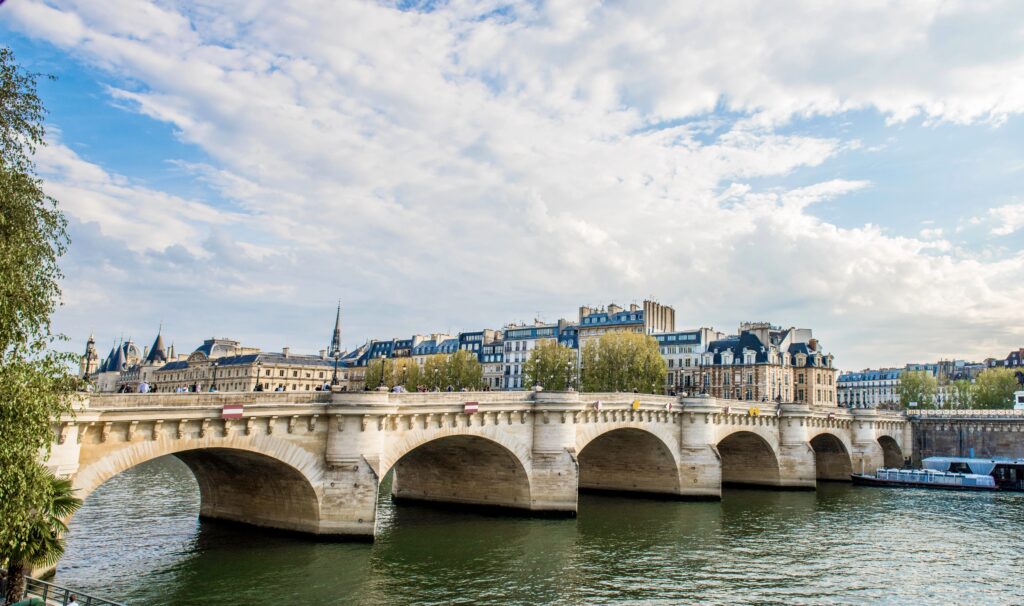
Pont Neuf
Despite its name, New Bridge, the Pont Neuf was built in 1604. That makes it the oldest bridge in Paris.
It was opened by Henri IV, whose statue on horseback graces the middle of the two spans.
The bridge crosses the Seine at the western tip of the Île de la Cité, connecting the Right and Left Banks.
The bridge is Romanesque in style, with twelves stone arches. The foundations are decorated with macaroons, grotesque stones meant to deter evil.
The bridge has a colorful history, formerly home to street vendors, villains, slave merchants, and entertainers. Today, you may find some scammers there asking you to sign fake petitions.
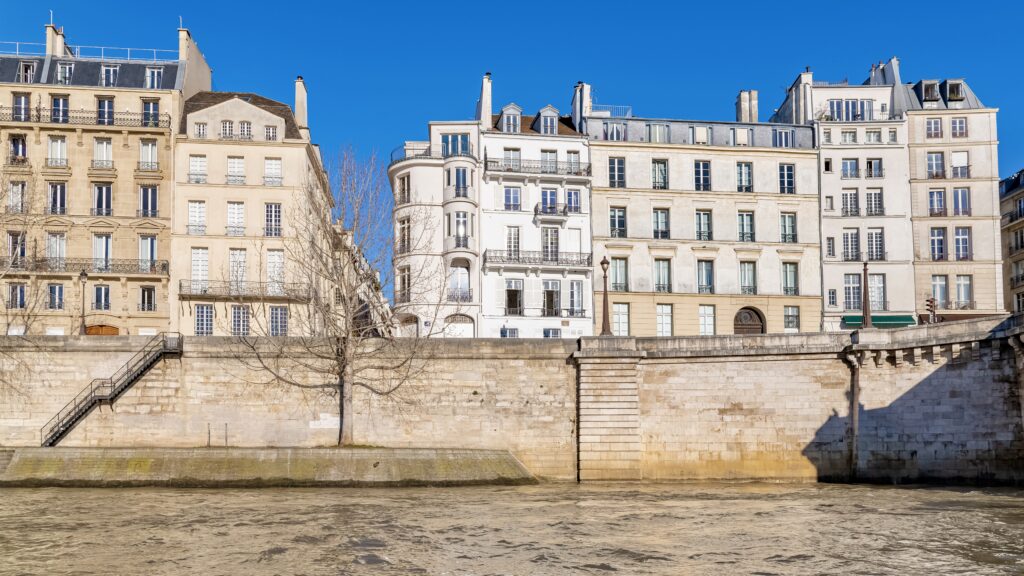
Île Saint-Louis
Cross the Pont St.-Louis to reach the Île Saint-Louis. There’s no landmarks to see really.
It’s a place for the casual flaneur. And the views from the islands’ quays are fabulous.
You can wander through the island’s quaint streets like Rue Saint-Louis en l’Île, the main thoroughfare. Admire the beautiful facades of historic buildings and private mansions (hôtels particuliers) from the 17th century.
Hotel de Jassaud on Quai de Bouton was where the French sculptor Camille Claudel lived in a studio. Hotel de Lauzun on Quai d’Anjou was where the poet Charles Baudelaire wrote much of The Flowers of Evil.
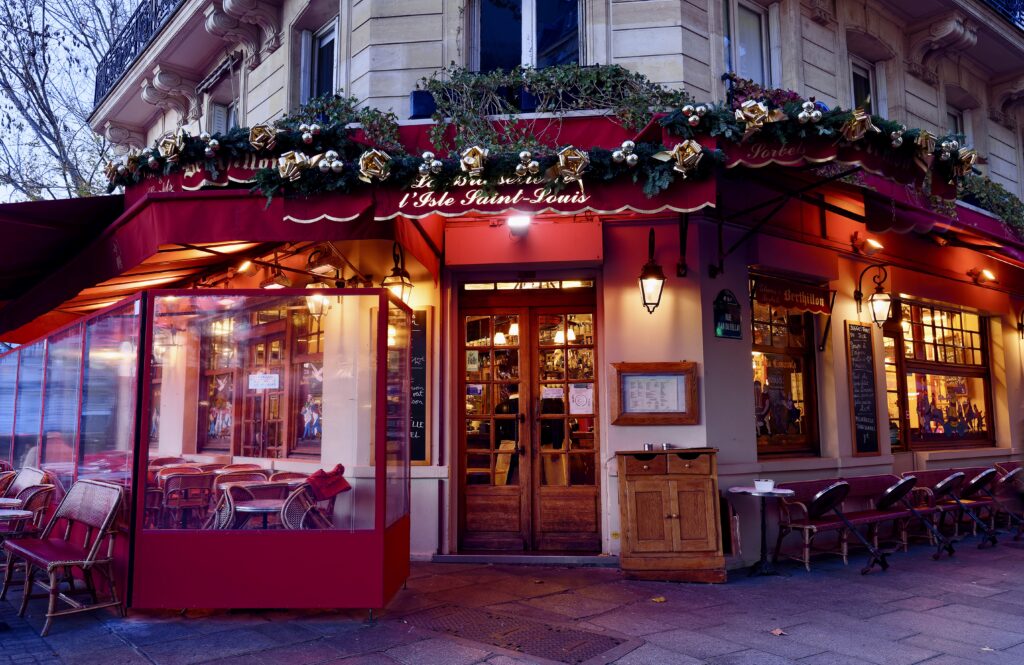
Stop to admire Saint-Louis-en-l’Île Church. The 17th century Baroque church is known for its charming interior and organ concerts. Its relatively modest exterior belies the artistic richness inside.
Finally, no visit to Île Saint-Louis is complete without tasting the famous Berthillon ice cream, known for its natural ingredients and variety of flavors. The original shop and several cafes on the island serve these delicious treats.
I hope you’ve enjoyed my guide to the islands of Paris. You may find these other Paris travel guides useful:
- 5 Day Itinerary for Paris
- 3 Day Itinerary for Paris
- 2 Day Itinerary for Paris
- Tips for Planning a Trip to Paris
- Top Attractions in Montmartre
- Top Attractions in the Latin Quarter
- Top Attractions in the Marais
- Best Museums In Paris
- Hidden Gems in Paris
Pin it for later.


